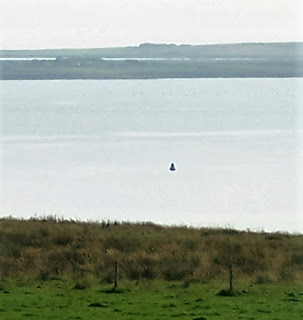 |
| Ducks come out to play |
Now we are in the Orkneys moored at the capital, Kirkwall.
And there was a bit of miscalculation on my part so far as my seat on the coach
was concerned. The tour didn't go in the direction I had expected so I was
sitting on the wrong side of the coach for taking some of the photos.
(By the way, if taking photos through a window do remember
to switch off the flash otherwise you take a photo of the flash. Flash
photography? Groan.)
We drove northwest to the coach road with its stunning views
of the Island of Rousay and the tidal roost on either side of the Isle of
Eynhallow. This is where the Atlantic Ocean and the North Sea meet. There we
saw a number of basking seals but brown on brown rocks made them difficult to
photograph.
Near the RSPB Reserve we made a stop at Birsay Bay. From there
we could see the sea bird cliffs at Marwick Head. Very noisy it was too. And,
of course, we couldn't miss the Neolithic Ring of Brodgar, a World Heritage
Site. We didn't stop there but we did stop at the Standing Stones of Stenness.
For me the icing on the cake was a chance to stroll the
streets of Stromness. This is a small fishing harbour across the water from the
island of Hoy. One of my favourite modern day classical composers lived, for
many years, on Hoy and wrote a gorgeous piano piece entitled 'Farewell to
Stromness'. Sir Peter Maxwell Davies who died in March 2016 at his home in
Sanday.
You want to know where the Old Man of Hoy is? The other side
of the island from Stromness.
As it was a Sunday all of the shops were closed - except one
where I bought a box of delicious home-made shortbread. Really melt in the
mouth. Yummy. Made me wish I'd bought two boxes.
 |
| The blob is the marker buoy over HMS Royal Oak |
The return journey was along the coast road overlooking
Scapa Flow, the stretch of water which played important roles in both World War
I and World War II. It was here at the end of WWI where the German Navy was
interned - and scuttled their ships which are still on the seabed. And it was
in October 1939 that a German submarine torpedo-ed and sank the HMS Royal Oak,
which also rests on the seabed.
For a day that had begun showery it ended up beautifully
sunny, for which we were grateful and it was a wonderful day.





No comments:
Post a Comment